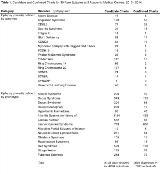Feasibility of Multicenter Keyword Text Search for Rare Epilepsy Surveillance
Abstract number :
2.108
Submission category :
4. Clinical Epilepsy / 4A. Classification and Syndromes
Year :
2018
Submission ID :
502447
Source :
www.aesnet.org
Presentation date :
12/2/2018 4:04:48 PM
Published date :
Nov 5, 2018, 18:00 PM
Authors :
Dale C. Hesdorffer, Columbia University; Zachary Grinspan, Weill Cornell Medicine; Elissa Yozawitz, Albert Einstein College of Medicine; Tiffani L. McDonough, Columbia University Medical Center; Steven Wolf, Icahn School of Medicine at Mount Sinai; Patric
Rationale: The rare epilepsies are a heterogeneous group of disorders that start in childhood and are associated with treatment resistant seizures and neurodevelopmental disabilities. Strong epidemiologic estimates exist for only few of these disorders. Published studies often examine the epidemiology of individual rare epilepsies, but it would be more efficient to simultaneously conduct surveillance for multiple rare epilepsies across a geographic region. The first step in such surveillance is to gather together charts electronically from multiple centers. Here we report results from a case finding exercise using text from physician notes from five academic medical centers in Bronx and Manhattan New York. Methods: We requested text from neurology notes from five academic medical centers from 2010 - 2014 for any individual with an ICD-9 code of 345.x (epilepsy), 780.39 (convulsion), or 779.0 (convulsion in neonate), using the New York City Clinical Data Research Network. We searched these notes for keywords, based on a published list (Grinspan et al Epilepsia Open 2018). Two reviewers examined the electronic chart for each patient with a key word, and determined if the individual had one of 30 rare epilepsies (Table 1). A third reviewer examined cases where there was disagreement. Results: We collected 653,280 notes written in 2010 - 2014 by neurologists from five academic medical centers in New York City from 77,924 individuals. Using key words, we selected 4676 patients (22,650 notes) for review. We identified 1781 charts with at least one rare epilepsy (or history of rare epilepsy) (Table 1). Conclusions: Aggregating notes from multiple centers is a feasible method to screen a population for rare epilepsies. In our ongoing work, we are de-duplicating charts, reconfirming diagnoses, and linking with demographic, comorbidity, and mortality information on these individuals in order to create population based epidemiological estimates. Funding: CDC
